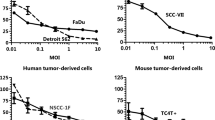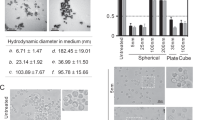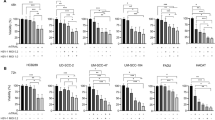Abstract
Current oncolytic viruses exert only limited antitumor activity on their own. There is a need to increase their oncolytic capability. We evaluated the effect of a differentiating reagent, hexamethylene bisacetamide (HMBA), on the antitumor activity of a γ134.5-deficient herpes simplex virus type 1 (HSV-1) R849 for human oral squamous cell carcinoma (SCC) cells. Hexamethylene bisacetamide increased the viral yield, especially at a low input multiplicity of infection (MOI), and the transcription of immediate early genes of HSV-1. Hexamethylene bisacetamide treatment promoted the cytopathic effect of R849 and increased the proportion of dead cells. Hexamethylene bisacetamide produced more apoptotic cells in R849-infected cells as compared with parental HSV-1(F)-infected cells. The growth of oral SCC xenografts in nude mice was markedly suppressed by treatment with R849 in combination with HMBA, and the survival of the co-treated animals was significantly prolonged as compared with that of animals treated with R849 only. Herpes simplex virus type 1 mRNA was expressed in tumors and trigeminal neurons, but not in brain, lung, liver, and kidney. These results indicate that HMBA enhances the antitumor activity of R849 through the expression of immediate early genes without increasing its toxicity. Hexamethylene bisacetamide can be used as an enhancing agent for oncolytic therapy with HSV-1 mutants.
This is a preview of subscription content, access via your institution
Access options
Subscribe to this journal
Receive 12 print issues and online access
$259.00 per year
only $21.58 per issue
Buy this article
- Purchase on Springer Link
- Instant access to full article PDF
Prices may be subject to local taxes which are calculated during checkout











Similar content being viewed by others
References
Vokes EE, Weichselbaum RR, Lippman SM, Hong WK . Head and neck cancer. N Engl J Med 1993; 328: 184–194.
Khuri FR, Lippman SM, Spitz MR, Lotan R, Hong WK . Molecular epidemiology and retinoid chemoprevention of head and neck cancer. J Natl Cancer Inst 1997; 89: 199–211.
Smith BD, Haffty BG . Molecular markers as prognostic factors for local recurrence and radioresistance in head and neck squamous cell carcinoma. Radiat Oncol Invest 1999; 7: 125–144.
Kirn D, Marutuza RL, Zwiebel J . Replication-selective virotherapy for cancer: biological principles, risk management and future directions. Nat Med 2001; 7: 781–787.
Chou J, Kern ER, Whitley RJ, Roizman B . Mapping of herpes simplex virus-1 neurovirulence to g1 34.5, gene non-essential for growth in culture. Science 1990; 250: 1262–1266.
MacLean AR, ul-Fareed M, Robertson L, Harland J, Brown SM . Herpes simplex virus type 1 deletion variants 1714 and 1716 pinpoint neurovirulence-related sequences in Glasgow strain 17+ between immediate early gene 1 and the ‘a’ sequence. J Gen Virol 1991; 72: 631–639.
Toda M, Rabkin SD, Martuza RL . Treatment of human breast cancer in a brain metastatic model by G207, a replication-competent multimutated herpes simplex virus 1. Hum Gene Ther 1998; 9: 2177–2185.
Walker JR, McGeagh KG, Sundaresan P, Jorgensen TJ, Rabkin SD, Martuza RL . Local and systemic therapy of human prostate adenocarcinoma with the conditionally replicating herpes simplex virus vector G207. Hum Gene Ther 1999; 10: 2237–2243.
Toyoizumi T, Mick R, Abbas AE, Kang EH, Kaiser LR, Molnar-Kimber KL . Combined therapy with chemotherapeutic agents and herpes simplex virus type 1 ICP34.5 mutant (HSV-1716) in human non-small cell lung cancer. Hum Gene Ther 1999; 10: 3013–3029.
Coukos G, Makrigiannakis A, Kang EH, Rubin SC, Albelda SM, Molnar-Kimber KL . Oncolytic herpes simplex virus-1 lacking ICP34.5 induces p53-independent death and is efficacious against chemotherapy-resistant ovarian cancer. Clin Cancer Res 2000; 6: 3342–3353.
Randazzo BP, Bhat MG, Kesari S, Fraser NW, Brown SM . Treatment of experimental subcutaneous human melanoma with a replication-restricted herpes simplex virus mutant. J Invest Dermatol 1997; 108: 933–937.
Mineta T, Rabkin SD, Yazaki T, Hunter WD, Martuza RL . Attenuated multi-mutated herpes simplex virus-1 for the treatment of malignant gliomas. Nat Med 1995; 1: 938–943.
Lee JH, Federoff HJ, Schoeniger LO . G207, modified herpes simplex virus type 1, kills human pancreatic cancer cells in vitro. J Gastrointest Surg 1999; 3: 127–131.
Carew JF, Kooby DA, Halterman MW, Federoff HJ, Fong Y . Selective infection and cytolysis of human head and neck squamous cell carcinoma with sparing of normal mucosa by a cytotoxic herpes simplex virus type 1 (G207). Hum Gene Ther 1999; 10: 1599–1606.
Wong RJ, Kim SH, Joe JK, Shah JP, Johnson PA, Fong Y . Effective treatment of head and neck squamous cell carcinoma by an oncolytic herpes simplex virus. J Am Coll Surg 2001; 193: 12–21.
Rampling R, Cruickshank G, Papanastassiou V, Nicoll J, Hadley D, Brennan D et al. Toxicity evaluation of replication-competent herpes simplex virus (ICP 34.5 null mutant 1716) in patients with recurrent malignant glioma. Gene Therapy 2000; 7: 859–866.
Markert JM, Medlock MD, Rabkin SD, Gillespie GY, Todo T, Hunter WD et al. Conditionally replicating herpes simplex virus mutant, G207 for the treatment of malignant glioma: results of a phase I trial. Gene Therapy 2000; 7: 867–874.
Taneja S, MacGregor J, Markus S, Ha S, Mohr I . Enhanced antitumor efficacy of a herpes simplex virus mutant isolated by genetic selection in cancer cells. Proc Natl Acad Sci USA 2001; 98: 8804–8808.
Bennett JJ, Adusumilli P, Petrowsky H, Burt BM, Roberts G, Delman KA et al. Up-regulation of GADD34 mediates the synergistic anticancer activity of mitomycin C and a gamma134.5 deleted oncolytic herpes virus (G207). FASEB J 2004; 18: 1001–1003.
Stanziale SF, Petrowsky H, Joe JK, Roberts GD, Zager JS, Gusani NJ et al. Ionizing radiation potentiates the antitumor efficacy of oncolytic herpes simplex virus G207 by upregulating ribonucleotide reductase. Surgery 2002; 132: 353–359.
Fu X, Tao L, Jin A, Vile R, Brenner MK, Zhang X . Expression of a fusogenic membrane glycoprotein by an oncolytic herpes simplex virus potentiates the viral antitumor effect. Mol Ther 2003; 7: 748–754.
Chahlavi A, Todo T, Martuza RL, Rabkin SD . Replication-competent herpes simplex virus vector G207 and cisplatin combination therapy for head and neck squamous cell carcinoma. Neoplasia 1999; 1: 162–169.
Sparatore B, Patrone M, Passalacqua M, Melloni E, Pontremoli S . Differentiation of murine erythroleukemia cells by hexamethylenebisacetamide involves secretion and binding to membranes of a differentiation enhancing factor. Biochem Biophys Res Commun 1991; 179: 153–160.
Bernstein DI, Kappes JC . Enhanced in vitro reactivation of latent herpes simplex virus from neural and peripheral tissues with hexamethylenebisacetamide. Arch Virol 1988; 99: 57–65.
McFarlane M, Daksis JI, Preston CM . Hexamethylene bisacetamide stimulates herpes simplex virus immediate early gene expression in the absence of trans-induction by Vmw65. J Gen Virol 1992; 73: 285–292.
Yura Y, Kondo Y, Iga H, Harada K, Tujimoto H, Yanagawa T et al. Enhanced replication of herpes simplex virus by hexamethylene bisacetamide. J Natl Cancer Inst 1991; 83: 186–189.
Andreansky S, Soroceanu L, Flotte ER, Chou J, Markert JM, Gillespie GY et al. Evaluation of genetically engineered herpes simplex viruses as oncolytic agents for human malignant brain tumors. Cancer Res 1997; 57: 1502–1509.
Hasina R, Matsumoto K, Matsumoto-Taniura N, Kato I, Sakuda M, Nakamura TH . Autocrine and paracrine motility factors and their involvement in invasiveness in a human oral carcinoma cell line. Br J Cancer 1999; 80: 1708–1717.
Minagawa H, Tanaka S, Toh Y, Mori R . Detection of herpes simplex virus type 1-encoded RNA by polymerase chain reaction: different pattern of viral RNA detection in latently infected murine trigeminal ganglia following in vitro or in vivo reactivation. J Gen Virol 1994; 75: 647–650.
Sundaresan P, Hunter WD, Martuza RL, Rabkin SD . Attenuated, replication-competent herpes simplex virus type 1 mutant G207: safety evaluation in mice. J Virol 2000; 74: 3832–3841.
Chen Z, Banks J, Rifkind RA, Marks PA . Inducer-mediated commitment of murine erythroleukemia cells to differentiation: a multistep process. Proc Natl Acad Sci USA 1982; 79: 471–475.
Chun HG, Leyland-Jones B, Hoth D, Shoemaker D, Wolpert-DeFilippes M, Grieshaber C et al. Hexamethylene bisacetamide: a polar-planar compound entering clinical trials as a differentiating agent. Cancer Treat Rep 1986; 70: 991–996.
McAuliffe PF, Jarnagin WR, Johnson P, Delman KA, Federoff H, Fong Y . Effective treatment of pancreatic tumors with two multimutated herpes simplex oncolytic viruses. J Gastrointest Surg 2000; 4: 580–588.
Kok SH, Cheng SJ, Hong CY, Lee JJ, Lin SK, Kuo YS et al. Norcantharidin-induced apoptosis in oral cancer cells is associated with an increase of proapoptotic to antiapoptotic protein ratio. Cancer Lett 2005; 217: 43–52.
Ito M, Watanabe M, Kamiya H, Sakurai M . Herpes simplex virus type 1 induces apoptosis in peripheral blood T lymphocytes. J Infect Dis 1997; 175: 1220–1224.
Galvan V, Roizman B . Herpes simplex virus 1 induces and blocks apoptosis at multiple steps during infection and protects cells from exogenous inducers in a cell-type-dependent manner. Proc Natl Acad Sci USA 1998; 95: 3931–3936.
He B, Gross M, Roizman B . The gamma(1)34.5 protein of herpes simplex virus 1 complexes with protein phosphatase 1alpha to dephosphorylate the alpha subunit of the eukaryotic translation initiation factor 2 and preclude the shutoff of protein synthesis by double-stranded RNA-activated protein kinase. Proc Natl Acad Sci USA 1997; 94: 843–848.
Yura Y, Tsujimoto H, Kusaka J, Yoshida H, Sato M . Hexamethylene bisacetamide as a chemopreventive agent in hamster cheek pouch tumorigenesis. Eur J Cancer B Oral Oncol 1996; 32B: 246–250.
Egorin MJ, Sigman LM, Van Echo DA, Forrest A, Whitacre MY, Aisner J . Phase I clinical and pharmacokinetic study of hexamethylene bisacetamide (NSC 95580) administered as a five-day continuous infusion. Cancer Res 1987; 47: 617–623.
Acknowledgements
We thank Dr B Roizman for providing R849. This investigation was supported in part by a Grant-in-aid for Scientific Research from the Ministry of Education, Science and Culture of Japan.
Author information
Authors and Affiliations
Corresponding author
Rights and permissions
About this article
Cite this article
Naito, S., Obayashi, S., Sumi, T. et al. Enhancement of antitumor activity of herpes simplex virus γ134.5-deficient mutant for oral squamous cell carcinoma cells by hexamethylene bisacetamide. Cancer Gene Ther 13, 780–791 (2006). https://doi.org/10.1038/sj.cgt.7700957
Received:
Revised:
Accepted:
Published:
Issue Date:
DOI: https://doi.org/10.1038/sj.cgt.7700957
Keywords
This article is cited by
-
Oncolytic activity of HF10 in head and neck squamous cell carcinomas
Cancer Gene Therapy (2020)
-
A novel fusogenic herpes simplex virus for oncolytic virotherapy of squamous cell carcinoma
Virology Journal (2011)
-
Effect of ultrasound on herpes simplex virus infection in cell culture
Virology Journal (2011)
-
Gene therapy: the end of the rainbow?
Head & Neck Oncology (2009)
-
The effects of trichostatin A on the oncolytic ability of herpes simplex virus for oral squamous cell carcinoma cells
Cancer Gene Therapy (2009)



